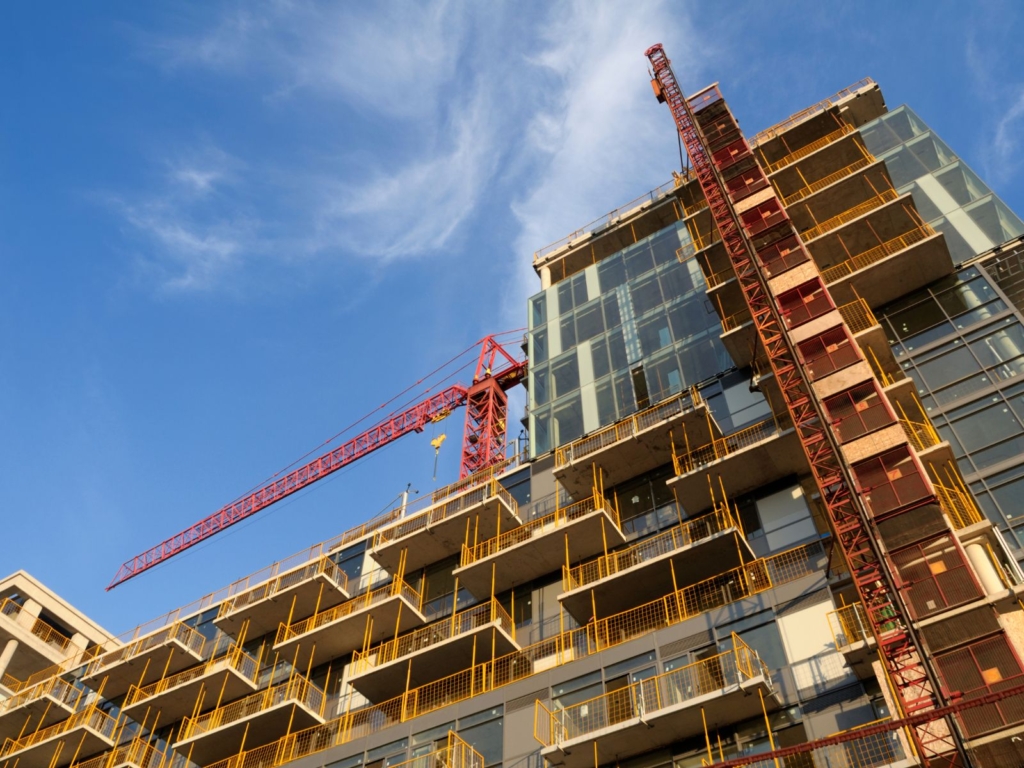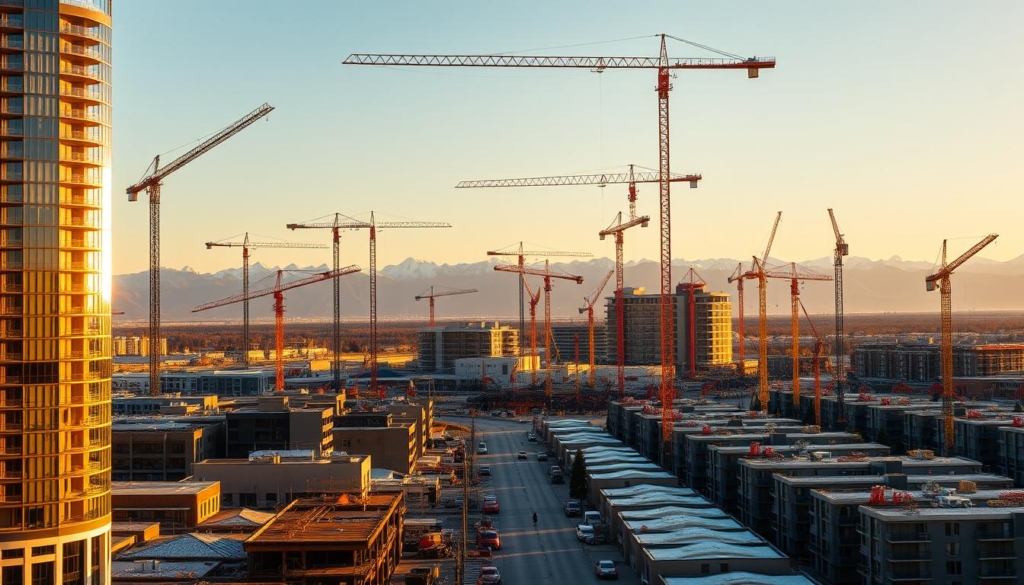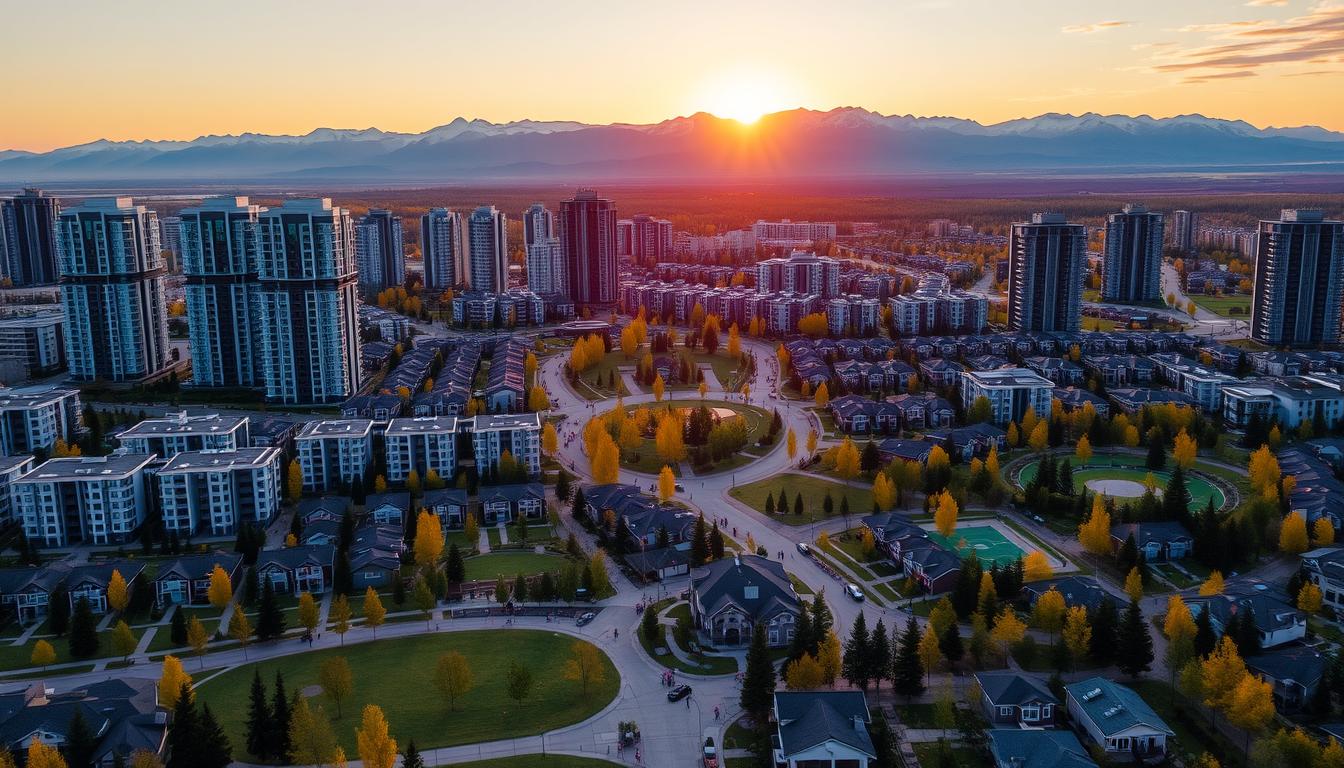Alberta’s real estate scene is changing a lot in 2025. New housing projects are opening up great chances for people looking to buy homes or invest. The province’s economy is growing fast, which is making big changes in the housing market.
New Homes Alberta is a key place to learn about these changes. With a 2.5% economic growth and new housing ideas, Alberta is becoming a top choice. It’s perfect for first-time buyers and investors looking for good deals.
The housing market in Alberta is doing well. The average home price is $493,828, which is a 1.3% drop each month but a 7.7% rise yearly. These numbers show a stable market with lots of investment chances.
Key Takeaways
- Alberta’s housing market shows strong growth in 2025
- New developments focus on being green and saving energy
- There are many housing types for different family sizes and budgets
- New residential areas are popping up in major cities
- The growing economy is expanding the real estate market
Overview of Alberta's Housing Market Growth
Alberta’s housing market is booming, thanks to strong economy and smart city planning. It’s now a top choice for real estate investors. Big changes are making its cities look new.
Current Market Statistics and Trends
The Alberta real estate market is showing fast growth and lots of chances. Here are some key numbers:
- Average home price in Alberta: $506,700
- Annual home price appreciation: 11.3%
- Total active real estate listings: 10,868
- Year-over-year price growth: 7%
Economic Growth Projections
Green building methods are key to Alberta’s housing market growth. Cities like Calgary and Edmonton are changing fast. They expect 4% more home sales in 2025.
“Alberta’s real estate market is not just growing; it’s strategically evolving with innovative urban planning strategies,” says a leading real estate analyst.
Population Impact on Housing Demand
Alberta’s growing population is driving up housing needs. Here’s what’s happening:
- Population growth of 19.8% from 2014 to 2024
- Q4 2024 population increase of 4.4%
- Highest provincial population growth rate in Canada
People moving from Ontario are boosting demand in cities like Calgary and Edmonton. This makes the real estate scene lively and full of life.
Record-Breaking Construction Activity in Alberta

Alberta’s housing market is booming in 2024. Construction activity has hit historic highs. The province is seeing a huge increase in new homes, changing the real estate scene.
Key highlights of the construction boom include:
- 46,632 new homes under construction in 2024
- 32% increase in housing starts compared to 2023
- Smart home technologies being integrated into new developments
Major cities are seeing big growth. Calgary’s housing starts jumped 24%, from 19,579 in 2023 to 24,396 in 2024. Edmonton’s housing starts rose 39%, from 13,184 to 18,384.
“Alberta is not just building homes; we’re crafting future living environments with innovative smart home technologies,” says a local urban development expert.
New Developments in Alberta Housing 2025 focus on sustainability and technology. Smart home technologies are key, improving energy use and living standards.
Smaller cities are growing fast too. Lethbridge saw a 194% increase in housing starts. Red Deer’s housing starts rose 84%. These numbers show Alberta’s housing market is strong and growing.
The construction sector is expected to hit $24 billion in 2025. Residential construction will create over 80,000 new homes. Multi-family dwellings will make up about 55% of this activity.
Population Growth and Housing Demand Analysis
Alberta’s housing market is changing fast because of population shifts and new urban plans. The province is drawing people from all walks of life. This brings both challenges and chances to the housing market.
Looking at population growth helps us understand housing needs. Data shows Alberta’s population might grow by about 1% in 2025. This is slower than the growth seen in earlier years.
Migration Patterns and Demographics
Alberta’s population changes because of several things:
- Interprovincial migration trends
- International immigration patterns
- Age distribution shifts
- Economic opportunities attracting newcomers
Impact on Housing Requirements
Urban planning is key to meeting new housing needs. The market expects big changes to fit the changing tastes of people.
| Housing Segment | Projected Demand | Key Characteristics |
|---|---|---|
| Single-Family Homes | Moderate Growth | Falling interest rates supporting demand |
| Multi-Family Apartments | Limited Growth | Potential oversupply concerns |
| Townhomes | Steady Demand | Attractive for first-time buyers |
Future Population Projections
Help for first-time buyers is getting more important for affordable housing. Calgary and Edmonton have strong housing markets. They are expected to keep up with the growing need for homes.
“Alberta’s housing market remains dynamic, balancing population growth with strategic urban development initiatives.”
Alberta’s average household size is 2.5 people. Homeownership costs are competitive. This makes Alberta appealing to both residents and investors.
New Developments in Alberta Housing 2025
Alberta’s housing scene is changing fast in 2025. This is thanks to new, green building methods and smart planning. The province is seeing a lot of new homes that meet many community needs.
Across Alberta, big changes are happening in housing. Alberta was the top in Canada for new homes started, with 46,632 homes being built. This is a 32% jump from last year.
“We’re witnessing a housing revolution that balances affordability, sustainability, and community design,” says Alberta Housing Development Council.
Key Development Highlights
- Record-breaking apartment unit starts with 9,903 units in the first half of 2024
- Significant housing start increases in Edmonton (39%) and Calgary (24%)
- Strategic focus on sustainable construction techniques
- Diverse housing options targeting different market segments
| City | Housing Starts | Growth Rate |
|---|---|---|
| Edmonton | 15,232 | 39% |
| Calgary | 12,876 | 24% |
| Lethbridge | 4,521 | 194% |
The government’s Affordable Housing Partnership Program gave $216 million in 2024. This shows their dedication to making housing more accessible. With a 2.9% population growth and 3.2% economic growth, Alberta’s real estate market is booming.
Green building is a big part of these changes. Homes are being built with energy-saving designs and materials. They also use new architectural ideas that are good for the planet and meet community needs.
Government Initiatives and Investment Programs
The Canadian government has launched many affordable housing initiatives. These efforts aim to help first-time buyers and create lasting housing solutions. They cover Alberta and the whole country.
The National Housing Strategy is a big step towards changing Canada’s housing. It shows the government’s strong commitment to making housing more accessible and affordable.
Federal Funding Allocations
The federal government has put a lot of money into housing:
- $1.35 billion for First-Time Homebuyer Incentive
- $4 billion for the Housing Accelerator Fund
- $15.7 billion for working with provinces and territories
- $541 million for new housing research and programs
Provincial Housing Strategies
Alberta is focusing on helping first-time buyers with special programs. The Affordable Housing Investment Program (AHIP) helps fund new housing projects.
| Program Feature | Details |
|---|---|
| Funding Percentage | Up to 25% of total costs |
| Grant Percentage | Up to 40% for certain projects |
| Application Deadline | April 25, 2025 |
Municipal Development Plans
Local governments are also working on affordable housing. Cities like Edmonton are tackling housing issues with specific plans. About 1 in 4 renter households in Edmonton struggle with housing costs.
“Our goal is to make housing accessible and sustainable for all Albertans. We want to help everyone achieve their dream of owning a home.” – Provincial Housing Authority Representative
Calgary's Real Estate Market Analysis
Calgary’s real estate market is strong and growing in 2025. The city is changing how it builds homes, making them better for today’s living needs.
The housing market in Calgary is full of life, with important numbers showing big trends:
- Total monthly home sales reached 1,451 units in January 2025
- Average home price increased to $605,026, showing a 6.3% rise from last year
- Benchmark home price stayed at $583,000
“Calgary’s real estate market reflects a balanced and strategic approach to urban development,” says local real estate expert.
Smart home tech is making homes better, with new digital features being added. These changes are making homes more appealing and raising their value.
| Property Type | Average Price | Year-over-Year Change |
|---|---|---|
| Detached Homes | $780,000 | +2.7% |
| Semi-Detached Homes | $667,000 | -0.1% |
| Townhouses | $466,000 | +6% |
| Condo Apartments | $353,000 | +4.7% |
Calgary’s market is strong thanks to its growing population. The city is adding people at a rate of 3.3% each year. This growth means more people need homes, pushing the demand for different types of housing.
Investors and buyers can look forward to a stable market with good growth chances. This is thanks to smart planning and the use of smart home technologies.
Edmonton's Urban Development Projects
Edmonton is going through a big change in urban development. The city has big plans to change its housing scene. These plans are making Edmonton a key player in growth.
The housing market in Edmonton is moving fast. The city is working hard to meet the needs of its growing population. Edmonton plans to build over 35,400 homes by November 2026. This shows the city’s commitment to building in a sustainable way.
Major Development Zones
Several areas are at the heart of Edmonton’s urban change:
- River Crossing: Aims to create up to 2,654 new homes
- Goodridge Corners: Plans to develop 243 acres for homes
- Heritage Valley Town Centre: Includes 119 acres with a big park
- Edmonton Exhibition Lands: A mixed-use project
Housing Start Statistics
The housing market in Edmonton is strong and growing. Last year, nearly 18,400 homes started construction in the area. This is the highest number in 47 years, up 5,200 from the year before.
Future Growth Areas
Edmonton is looking to the future with new ideas. A new zoning law, starting January 1, 2024, allows up to eight homes on most lots. The federal government is also supporting these plans with over $175 million.
“Edmonton is not just building houses; we’re creating communities for the future.” – City Development Official
Edmonton is expected to grow by 117,000 people by 2024. The city is preparing to be a vibrant, sustainable place with homes that meet the needs of its people.
Sustainable Housing Initiatives
Alberta is leading the way in new, green building methods. These methods combine smart home tech and eco-friendly designs. This is changing how homes are built in the province.
“Sustainability is not just an option, but a fundamental approach to modern housing,” says a leading Alberta housing expert.
The province is focusing on several key areas for sustainable housing:
- Energy-efficient building materials
- Advanced water conservation systems
- Smart home technologies for reduced environmental impact
- Innovative design strategies
Building methods in Alberta are getting smarter and greener. Developers are using new ways to cut down on carbon emissions. At the same time, they’re making homes more comfortable and efficient.
| Initiative | Environmental Impact | Cost Savings |
|---|---|---|
| Solar Panel Integration | Reduced Carbon Emissions | Up to 70% Energy Cost Reduction |
| Rainwater Harvesting | Water Conservation | 30-50% Water Bill Reduction |
| Smart Home Energy Management | Optimized Resource Use | 25% Lower Energy Consumption |
The Sustainable Housing Initiative (SHI) in Fairview shows Alberta’s dedication to green homes. It aims to improve housing in both cities and towns. This is making communities better for the long run.
Government support is helping make green building more common. This not only helps the planet but also saves money for homeowners and builders.
Investment Opportunities in Alberta Real Estate
Alberta’s real estate market is full of exciting investment chances. It’s perfect for those who want to make money with new urban planning ideas. The province’s strong economy means there are many ways to earn money through different types of properties.
Market Trends and Forecasts
Investors will find great chances in Alberta’s real estate. The new housing plans for 2025 are opening up big investment opportunities. The market looks set to grow fast:
- Average house price in Alberta: $480,000
- Projected population in 2025: 4,800,768
- Annual job growth rate: 8.4%
Return on Investment (ROI) and Its Importance
Alberta offers many investment options with good returns:
| Investment Type | Potential ROI |
|---|---|
| Rental Properties | 8-12% |
| House Flipping | 10-20% |
| Real Estate Investment Trusts (REITs) | 5-10% |
Prime Investment Locations
Urban planning strategies are changing Alberta’s real estate. The best places to invest are:
- East Village: $500,000 with 10% annual growth
- Bridgeland: $450,000 with 8% annual growth
- Inglewood: $400,000 with 6% annual growth
“New developments in Calgary are positioning investors for maximum returns by acting before market trends shift.” – Real Estate Experts
Investors should look into the CMHC MLI Select Program. It offers a 5% down payment and 50-year mortgages. With the chance to have up to 5 investment properties, Alberta’s market is a great place for financial growth.
Infrastructure Development and Housing Impact

Alberta’s infrastructure is changing the housing market in big ways. The province is investing in new urban planning strategies. This is creating new chances for homes and technology to come together.
Big changes are happening in Alberta’s housing because of new infrastructure. With the economy growing 2.5% in 2024, cities are getting bigger. Smart home tech is becoming a key part of these new places, making life better for residents.
“Infrastructure is the backbone of urban transformation, connecting communities and driving housing innovation.” – Alberta Urban Development Council
- 46,632 new homes under construction in 2024
- 33% increase in housing starts compared to 2023
- Over 10,000 jobs created through infrastructure projects
Now, urban planning is all about making communities better and more tech-savvy. Smart home tech is changing how we live in homes. It makes them more efficient and connected.
| Infrastructure Investment Area | Total Investment | Housing Impact |
|---|---|---|
| Digital Infrastructure | $20 billion | Enhanced connectivity for new developments |
| Renewable Energy Projects | $4 billion | Sustainable housing solutions |
| Transportation Networks | $1.6 billion | Improved access to new housing zones |
The province’s focus on infrastructure is opening up new chances for housing. Emerging technologies and smart urban planning are changing Alberta’s homes. They promise more connected, efficient, and green living spaces.
Technology Integration in New Housing Projects
Alberta’s housing scene is changing fast, thanks to smart home tech and green building methods. The province is leading the way in tech for homes, changing how we see modern living.
Edmonton is at the forefront of smart homes, with builders using the latest tech. They’re making homes that are not just comfy but also save energy and are good for the planet.
Smart Home Features Redefining Residential Living
- Energy monitoring systems with real-time consumption tracking
- Voice-controlled home automation devices
- Advanced security networks with integrated AI technologies
- Customizable climate control solutions
Digital Infrastructure Innovations
Fast internet and digital networks are changing how we connect at home. Homes are now built with strong digital setups for easy tech use.
Energy Management Systems
| Technology | Benefits | Energy Savings |
|---|---|---|
| Solar Roofing | Renewable Energy Generation | Up to 70% reduction |
| Smart Battery Storage | Power Management | 25-40% efficiency increase |
| Advanced Insulation | Thermal Performance | Up to 50% heat retention |
“Technology is not just changing homes; it’s creating intelligent living environments that respond to residents’ needs,” says Alberta Housing Innovation Expert.
The future of homes in Alberta is all about smart tech for better living. These changes are more than just looks; they’re a new way to think about home.
Affordable Housing Solutions
Alberta is changing how it deals with affordable housing. It’s focusing on helping first-time buyers and those with lower incomes. The government is putting in $150 million through the Alberta Affordable Housing Partnership Program (AHPP) in 2025.
Alberta is making big moves to meet housing needs. It has invested $850 million to build over 5,100 housing units and more than 900 shelter spaces. This shows a strong commitment to making housing more accessible.
“Our goal is to ensure every Albertan has access to safe, affordable housing,” says a provincial housing spokesperson.
Innovative Housing Support Programs
- First-time buyer assistance programs offer financial help
- Mixed-income development projects
- Community land trust initiatives
- Targeted housing grants for specific groups
The federal government has pledged over $115 billion for housing. This will help create more than 156,000 new units and fix nearly 297,000 homes. In Edmonton, $9.2 million will fund 138 new affordable housing units. This shows a focused effort to meet housing needs.
Strategic Investment Breakdown
| Investment Area | Total Commitment | Units Created/Repaired |
|---|---|---|
| Affordable Housing Fund | $10.34 billion | 40,000 created, 166,000 repaired |
| Rapid Housing Initiative | Part of $57.57 billion | 16,000 units expected |
Budget 2024 shows even more commitment to affordable housing. It allocates an extra $840 million over three years. This is important because over 170,000 Alberta households were in housing need in 2022.
Market Predictions and Future Trends
Alberta’s housing market is on the verge of big changes in 2025. New urban planning strategies will shape the future of housing. The real estate sector is set for a strategic shift, influenced by economic and demographic changes.
Price Forecasts
Calgary’s housing market is set for an interesting year in 2025. The Calgary Real Estate Board (CREB) predicts over 26,000 home sales. This shows a stable market.
Citywide prices are expected to grow by 3%, down from the 7% increase in 2024. This moderation is a key trend to watch.
- Detached market forecasted to reach 12,600 units
- Condo market projected with a 1.8% price increase
- Lower-priced homes anticipated to experience steeper price appreciation
Supply and Demand Projections
Alberta’s economy is creating new opportunities for housing. The province is likely to attract many newcomers. This is due to its affordability and strong job markets in Calgary and Edmonton.
“Calgary’s housing market sales are expected to be 20% above long-term trends through 2025” – Real Estate Experts
Market Stability Indicators
Several factors will impact market stability in 2025:
- Interest rates expected to stabilize
- Reduced federal immigration targets
- Growing tech and clean energy sectors
- Potential economic risks from U.S. trade policies
Developers are using AI to better understand the market. This shows a smart approach to market dynamics.
Economic Factors Influencing Housing Growth
Alberta’s housing market is changing fast, thanks to many economic factors. Urban planning and green building are key to this change. They help the province’s real estate grow in a good way.
The province’s economy is strong, with growth rates of 2.5% in 2023 and 2.8% in 2024. This growth affects housing development and investment chances.
“Economic stability is the cornerstone of robust housing market expansion” – Alberta Economic Development Report
Key Economic Influences on Housing
- Provincial GDP growth trends
- Employment rate fluctuations
- Industry diversification impact
- Interest rate dynamics
Green building is getting more important in urban planning. It helps the environment and saves money for developers and homeowners in the long run.
| Economic Indicator | 2024 Projection |
|---|---|
| Average Home Price | $500,173 |
| Year-over-Year Price Increase | 11.3% |
| Total Residential Sales | 5,589 |
| Sales-to-New Listings Ratio | 86% |
The mix of economic factors and housing market trends is shaping Alberta’s real estate. It offers great chances for investors and homebuyers.
Regional Development Highlights
Alberta’s housing scene is changing fast. New projects are popping up everywhere, showing off smart ways to build cities and communities. These projects use the latest in smart home tech and meet the growing need for homes.
Alberta is focusing on green and smart homes all over the province. Here are some big highlights:
- Red Deer is getting a $203 million Justice Centre with 12 new courtrooms
- There are 10 new schools being built, making room for 9,600 students
- Hospital projects are underway to improve healthcare
The New Developments in Alberta Housing 2025 plan is all about variety and tech. Cities like Calgary and Edmonton are at the forefront. They’re making homes smarter, improving life for everyone.
| City | Housing Median Price | Rental Vacancy Rate |
|---|---|---|
| Calgary | $690,000 | 1% |
| Edmonton | $490,000 | 1.1% |
“Alberta’s regional development strategy is not just about building houses, but creating intelligent, connected communities,” says urban planning expert Jane Thompson.
Smart home tech is changing how we live in Alberta. From controlling energy to keeping homes safe, these new features are making homes better.
Energy Sector Impact on Housing Development
Alberta’s energy sector is key in shaping the housing market. The Trans Mountain Pipeline expansion has led to a lot of construction. This has made urban planning in Calgary and Edmonton focus more on sustainable building.
The TMX pipeline opening has raised energy prices and boosted production. This has helped the housing and construction markets grow. Alberta’s economy is expected to grow, making real estate investments more attractive. Now, more homes are built using green building methods, showing the industry cares about the environment.
Urban planning in Alberta has changed because of the energy sector’s impact. Calgary is moving away from just oil and gas to tech and finance. This shift has made the housing market stronger. House prices in Calgary and Edmonton are expected to rise, showing the sector’s positive effect.
Even with possible economic hurdles, the energy sector is vital for housing in Alberta. Calgary is set to see 2% job growth in 2025. This, along with smart city planning, highlights the sector’s role in a thriving real estate scene.





